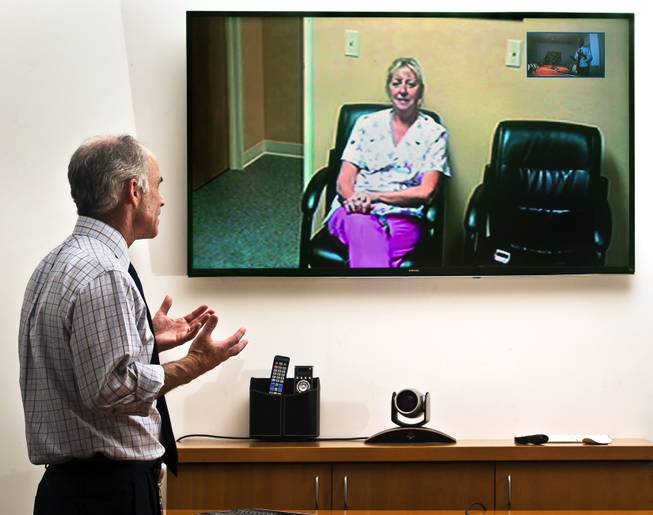
Dr. Charles Bernick at the Lou Ruvo Center for Brain Health conducts a telehealth session with Sue Burich who is a nurse supervisor at the Ruvo Center in Elko, Nevada.
Thursday, July 25, 2019 | 2 a.m.
The Nye County canyon in which Lorinda Wichman lives is 240 miles from Pahrump and 86 miles from Tonopah. It is home to four households, seven people and has no high-speed internet service.
Wichman, a Nye County commissioner, and her husband work from home, which she said “floods the internet.” Near the end of every month, she said, she receives a notice from HughesNet, her service provider, that she has used up her bandwidth — the amount of data she can use in a month.

U.S. Rep. Steven Horsford, D-Nev.
The plan is expensive — in Las Vegas, a plan with twice as much or more bandwidth per month is $20 cheaper on CenturyLink, a broadband provider. This is the reality that some rural Nevadans are faced with: restrictive plans that cost more than what’s available in the cities.
Congressman Steven Horsford, a North Las Vegas Democrat whose district includes Wichman’s home near Round Mountain, has made increasing access to rural broadband one of his political priorities. Earlier this month he announced that two internet companies operating in his district would receive $2.6 million in federal funding to boost rural Nevada broadband.
The funding, which comes from a $5.6 million allocation from Federal Communications Commission’s Connect America Fund, will help expand internet connectivity in underserved areas of Clark, Nye and Douglas counties.
Internet availability, Horsford said, “is one of the major issues that I hear from my constituents in rural Nevada.”
The 4th Congressional District, which Horsford represents, is massive. It includes most of North Las Vegas but also the entirety of White Pine, Esmeralda, Nye, Mineral and Lincoln counties, plus part of Lyon County.
The sheer mass of Horsford’s district means access to affordable high-speed broadband in rural areas is a salient issue. One pressing issue regarding higher internet speeds is the rising use by hospitals of telehealth services, in which health care professionals pay virtual visits with patients via computer or mobile devices. In areas as sparsely populated as rural Nevada, residents can sometimes be miles from the nearest hospital, so remote health care can be a necessity.
Horsford in March toured rural health clinics with Geoffrey Starks, an FCC commissioner, to draw attention to the need for help in broadening rural broadband expansion.
“This is a big priority for Commissioner Starks, and as a part of that trip I was able to highlight some of the needs in my district and emphasize the fact that we needed additional support and resources to our district,” Horsford said.
A lack of high-speed internet can cause burdens that aren’t as visible, as well. Timothy Hipp, an Esmeralda County commissioner, said there were situations in which a slower internet speed could create financial burdens that those who take fast internet for granted may not consider.
As an example, he said Esmeralda County residents who wanted to watch certain shows would have to pay for satellite TV rather than using streaming services like Netflix or Hulu, which would generally cost less.
The extension of high-speed internet to his area has saved people money. “That kind of has opened up things,” he said.
The governor’s office has estimated that around 220,000 Nevadans lack access to wired connection capability with download speeds of 25 Mbps, a speed that is generally enough to use video streaming or online gaming services but slow for large file downloads. The office also found that 100,000 Nevadans live in places where there is no wired internet.
Sen. Jacky Rosen, D-Nev., is working on an effort to increase the federal government’s knowledge of which areas are struggling in their internet coverage.
Rosen has co-sponsored the Broadband Deployment Accuracy and Technological Availability Act, which would increase mapping of areas’ internet coverage. The legislation this week was approved by the Senate Commerce Committee.
“Nevadans in every corner of the state deserve access to a high-speed broadband connection. In order to achieve this, we must have the most up-to-date mapping to ensure we can provide internet coverage to every rural and underserved community,” Rosen said in a statement.
Not all rural areas lack broadband. Areas in Esmeralda County, one of the least-populous counties in the nation, has broadband access now.
For students in Esmeralda County, the use of electronic tablets in the classroom used to be, at times, frustrating. The lack of high-speed internet access led to a system overload when the students tried to use their devices.
“When you have 15 to 20 kids all getting on the internet at the exact same time, it just would crash,” Hipp said.
Extending internet connections in rural Nevada can be difficult, Horsford said, due to the sheer amount of public lands controlled by federal agencies and military activity. The federal government owns nearly 85 percent of the land within the state. This means that, for example, extending infrastructure such as fiber optic broadband cables to some areas would require working through federal land.
Horsford said that rural Nevadans want further connection to make their lives easier and increase access to services that are much easier to access in areas with solid internet coverage.
“They want to be able to be connected for the purposes of having a good quality of life,” he said.
